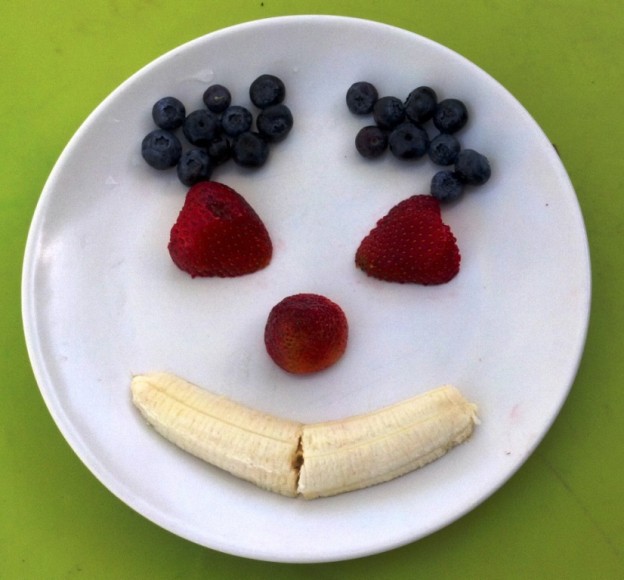Eating is such a personal topic, some people love to eat, and others hate to eat. Some folks over eat, some forget to eat, some eat slowly, and some eat fast and often people are very defensive regarding their choices or habits. Anyone who has ever tried to research diet and nutrition also knows there is a vast, overwhelming sea of conflicting information out there over what to eat, how much of it, when to eat it, ways to prepare it, where to find it, etc.
Last time I was here talking about how we are still breastfeeding past age one, but today I am discussing baby’s other nutrition, solid foods! We first introduced solids at six months old and I thought I would share some things we have implemented over the past eight months that we believe will help our son establish a healthy relationship with food and learn to nourish himself optimally from the very start.
Baby Led Weaning:
Krystyna chronicled her family’s journey with Baby Led Weaning and their youngest child in detail here if you are interested in more information about the actual approach and implementation. We chose BLW because it allows baby to explore food in different forms, exposes them to different tastes and textures depending on preparation, is aligned with our “whole foods” approach to eating and most importantly allows baby to have control over physically feeding him or herself along with determining when to stop or continue eating.
Meal Times & The Family Table:
When we first began giving my son, T, food to explore he sat in his Bumbo with attached tray. We would sit on the floor next to him and eat our food while he spent time discovering the food in front of him.
 First Foods
First Foods
When he outgrew the Bumbo seat we got a highchair that goes on one of the kitchen table chairs and pulls right up to the table, no attached tray.
 At our table – clearly, he is comfortable.
At our table – clearly, he is comfortable.
When he became increasingly more mobile and not content in the high chair, around a year old, we got a low to the ground kitchen table with floor cushions for our dining area and a wooden child size table and two chairs for his room. At the dining table he gets in and out of his chair when he wants, sometimes eats standing up at the table, and sometimes grabs food off of our plates. The table in his room usually has some snacks on it throughout the day for him to graze. I know this isn’t practical or conducive to everyone’s lifestyle, but it works for us. We love being on our son’s level and spend most of our days on the floor with him anyways so sitting on the floor at a low dining table isn’t really that much of an adjustment for us. We always place his food directly on whichever table we are eating from and use this silicone placemat from Green Sprouts.
 Enjoying a snack at his table.
Enjoying a snack at his table.
 Unconventional eating 🙂
Unconventional eating 🙂
Incorporating our son into our meal times, what we are eating ourselves and the table we are eating it from, has been very important to us. We want him to see us fueling our bodies with the same things he is. We want him to hear as I tell my husband what I have prepared that night and how and to be involved in the mealtime because he wants to be, not just because he is constrained.
Variety of Healthy Choices:
We offer a variety of choices all day, every day. For breakfast it is usually two or more options rotating between fruits, soaked oatmeal, eggs, green smoothies, coconut/almond yogurt, and nut butters. Mid day snacks and lunch always consist of multiple different foods as well: quinoa, vegetables, rice, olives, possibly more fruit, avocados, more nut butters, hummus, beans, chicken, and fish and dinner is his own serving of whatever my husband and I are having. He honestly doesn’t have foods that he “hates” or “loves” yet, sometimes he will reject things, and sometimes he will gobble up those same foods. Sometimes he throws food on the floor; sometimes he feeds food to the dog. Sometimes he chews his food and spits it out and sometimes he wants me to eat something first and then he will. I don’t react to any of this behavior, when it comes to food, I am in charge of providing the options and he is in charge of what he does with them. No matter the outcome I continue offering a rotating variety of seasonal, whole foods.
Limit Refined Sugar & Sweeteners:
We had an absolute, hard and fast NO refined sugar or sweeteners rule until 12 months. Around twelve months I began using small bits of maple syrup to sweeten things like pancake batters and chia puddings. Around that time we also introduced raw, local honey for the first time and now use that sparingly in things like dressings, marinades, etc. We are very limited on the number of packaged foods T eats but there have been a couple of times he has been given good quality snack type bars with agave or some organic, gluten free snack bunnies that have cane sugar in them as a special treat in the car seat. I strongly believe that by very strictly limiting refined sugar and sweetener intake it allows his natural taste preferences for real, whole foods to flourish.
Relaxed Attitude:
Overall, I think our relaxed attitude towards eating behavior is what we feel will benefit our son’s eating habits the most. Sometimes I wake up in the morning and am starving, sometimes I have things I want to do first before I eat, and sometimes I don’t find myself hungry until 10 or 11 AM. In these instances my husband doesn’t force me to sit down and eat breakfast with him or ever force me to eat foods that don’t sound appealing. Some days certain things sound good, and others days they do not. Keeping in mind that our little man is just the same as us in this regard allows me to feel good about letting him choose how and when and what he eats. As long as all of the options provided are healthy, it makes no difference to me. I also always remember that he is still breastfeeding, so if he doesn’t eat a large quantity one day, there is no need to stress. He is getting plenty of nutrition from my milk and he will make up for it by eating more food in the coming days. Empowering T to not only choose but also then physically feed himself feels so great; watching him navigate food and eat still brings me joy like I am seeing it for the first time. It is much messier, sometimes wasteful, much more inconvenient at times, and takes a lot of work to not only prepare fresh food AND multiple options, but, as the saying goes: “Nothing worth doing is ever easy”. Doing what I believe could help my son learn to sustain his body naturally and optimally is definitely worth it to me!
I could talk food and eating all day and would love to hear from you in the comments! How do you feed your baby or toddler? Have you seen the impacts of your choices on your older children if you have them? What do you think best creates a healthy relationship with food and eating?
Like this:
Like Loading...






